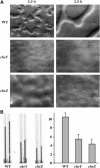Sensing wetness: a new role for the bacterial flagellum
- PMID: 15889148
- PMCID: PMC1142604
- DOI: 10.1038/sj.emboj.7600668
Sensing wetness: a new role for the bacterial flagellum
Abstract
We have uncovered a new role for the bacterial flagellum in sensing external wetness. An investigation into why mutants in the chemotaxis signaling pathway of Salmonella typhimurium exhibit fewer and shorter flagella than wild-type when propagated on a surface, first showed that the mutants downregulate only a small set of genes on swarm media--class 3 or 'late' motility genes, and genes associated with the pathogenicity island SPI-1 TTSS (type three secretion system). Based on observations that swarm colonies of the mutants appear less hydrated, we tested a model in which the flagellum itself is a sensor: suboptimal external hydration interferes with secretion of flagellin subunits, inhibiting filament growth and blocking normal export of the class 3 transcription inhibitor FlgM. We provide strong experimental support for the model. In addition, the data show that the flagellar and SPI-1 TTSS are coupled via regulatory proteins. These studies implicate the flagellum, a bacterial organ for motility, in sensing the external environment to modulate not only its own biogenesis but other physiological functions as well.
Figures








Similar articles
-
Gene expression patterns during swarming in Salmonella typhimurium: genes specific to surface growth and putative new motility and pathogenicity genes.Mol Microbiol. 2004 Apr;52(1):169-87. doi: 10.1111/j.1365-2958.2003.03977.x. Mol Microbiol. 2004. PMID: 15049819
-
Swarming motility: it better be wet.Curr Biol. 2005 Aug 9;15(15):R599-600. doi: 10.1016/j.cub.2005.07.042. Curr Biol. 2005. PMID: 16085482 Review.
-
A mechanical role for the chemotaxis system in swarming motility.Mol Microbiol. 2006 Jun;60(6):1590-602. doi: 10.1111/j.1365-2958.2006.05208.x. Mol Microbiol. 2006. PMID: 16796690
-
DNA adenine methylation regulates virulence gene expression in Salmonella enterica serovar Typhimurium.J Bacteriol. 2006 Dec;188(23):8160-8. doi: 10.1128/JB.00847-06. Epub 2006 Sep 22. J Bacteriol. 2006. PMID: 16997949 Free PMC article.
-
Spinning tails: homologies among bacterial flagellar systems.Trends Microbiol. 1996 Jun;4(6):226-31. doi: 10.1016/0966-842X(96)10037-8. Trends Microbiol. 1996. PMID: 8795158 Review.
Cited by
-
flrA, flrB and flrC regulate adhesion by controlling the expression of critical virulence genes in Vibrio alginolyticus.Emerg Microbes Infect. 2016 Aug 3;5(8):e85. doi: 10.1038/emi.2016.82. Emerg Microbes Infect. 2016. PMID: 27485498 Free PMC article.
-
Surface colonization by marine roseobacters: integrating genotype and phenotype.Appl Environ Microbiol. 2009 Oct;75(19):6027-37. doi: 10.1128/AEM.01508-09. Epub 2009 Aug 7. Appl Environ Microbiol. 2009. PMID: 19666726 Free PMC article. Review.
-
Studying the dynamics of flagella in multicellular communities of Escherichia coli by using biarsenical dyes.Appl Environ Microbiol. 2010 Feb;76(4):1241-50. doi: 10.1128/AEM.02153-09. Epub 2009 Dec 18. Appl Environ Microbiol. 2010. PMID: 20023074 Free PMC article.
-
Enterobacterial common antigen integrity is a checkpoint for flagellar biogenesis in Serratia marcescens.J Bacteriol. 2008 Jan;190(1):213-20. doi: 10.1128/JB.01348-07. Epub 2007 Nov 2. J Bacteriol. 2008. PMID: 17981971 Free PMC article.
-
T-POP array identifies EcnR and PefI-SrgD as novel regulators of flagellar gene expression.J Bacteriol. 2009 Mar;191(5):1498-508. doi: 10.1128/JB.01177-08. Epub 2008 Dec 29. J Bacteriol. 2009. PMID: 19114490 Free PMC article.
References
Publication types
MeSH terms
Substances
Associated data
- Actions
- Actions
- Actions
- Actions
- Actions
- Actions
- Actions
- Actions
- Actions
- Actions
- Actions
- Actions
- Actions
- Actions
- Actions
- Actions
- Actions
- Actions
- Actions
- Actions
- Actions
- Actions
- Actions
- Actions
- Actions
- Actions
- Actions
- Actions
- Actions
- Actions
- Actions
- Actions
- Actions
- Actions
- Actions
- Actions
- Actions
- Actions
- Actions
- Actions
- Actions
- Actions
- Actions
- Actions
- Actions
- Actions
- Actions
- Actions
- Actions
- Actions
- Actions
- Actions
- Actions
- Actions
Grants and funding
LinkOut - more resources
Full Text Sources
Other Literature Sources
Molecular Biology Databases

